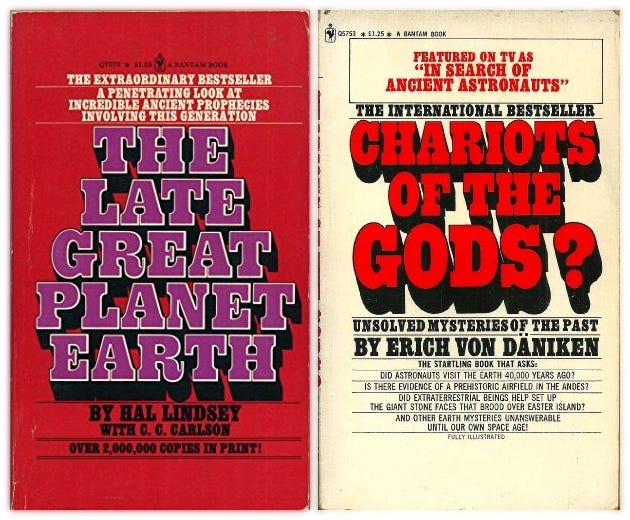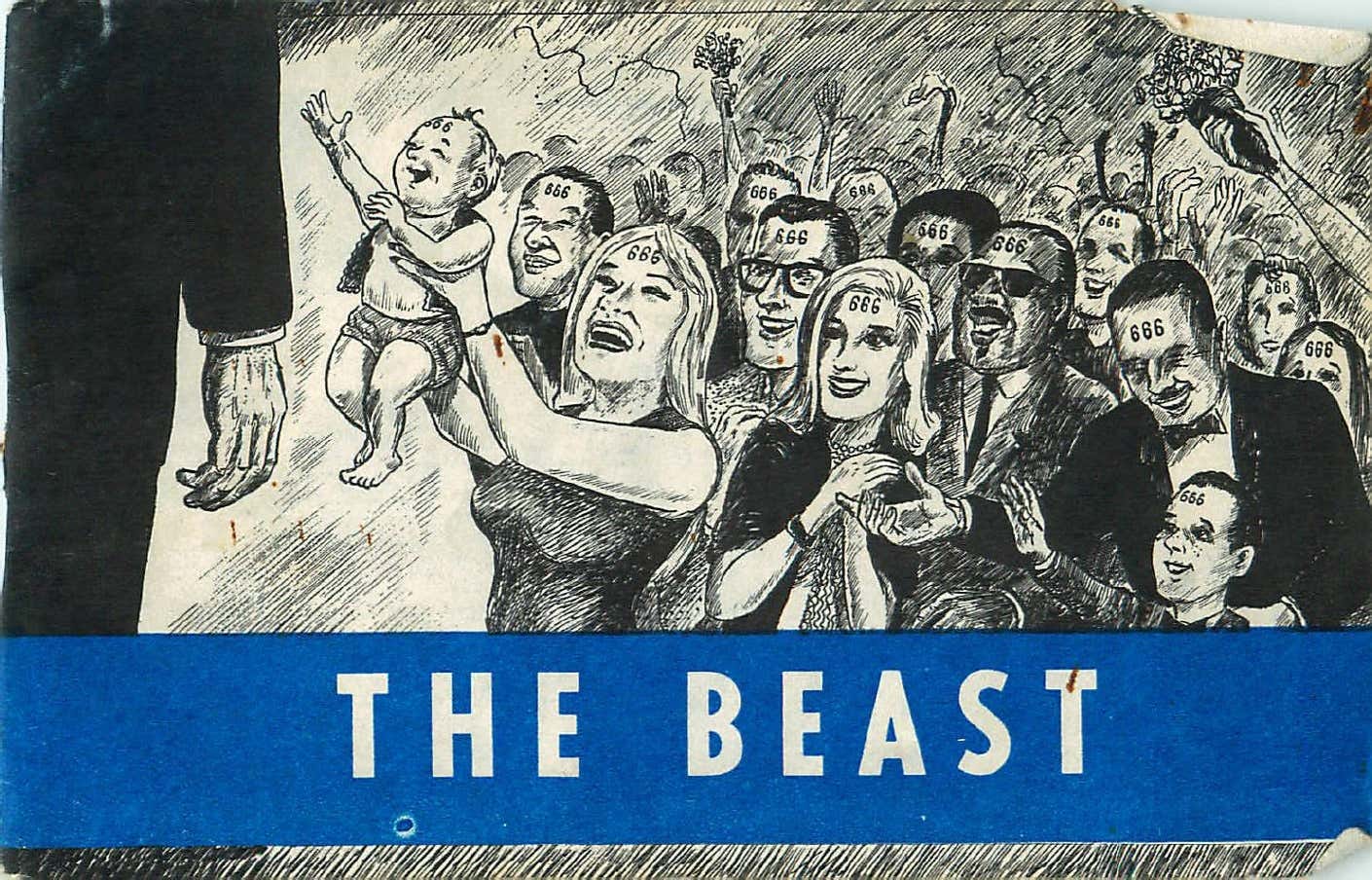Ga offline met de app Player FM !
Episode 8: The End Times Industrial Complex
Manage episode 293667834 series 2932741
Apocalyptic narratives have shaped Christian tradition for millennia, but growing demand for “standardized” Christian reading materials at the turn of the 20th century turned End Times theology into big business. Jeff and Kristin follow the rise of the Christian publishing and media industry, zeroing in on key “crossover” hits that transformed Dispensationalist theology into a pop culture powerhouse.
Core Reading
American Apocalypse: A History of Modern Evangelicalism, by Matthew Avery Sutton
Superchurch: The Rhetoric and Politics of American Fundamentalism, by Jonathan J. Edwards (Table of contents and summary)
Evangelicals Incorporated: Books and the Business of Religion in America, by Daniel Vaca
What Would Jesus Read?: Popular Religious Books and Everyday Life in Twentieth-Century America, by Erin A. Smith
Selected Excerpts
By investing early in premillennialism and dispensationalism, the Revell Company not only presented its books as means by which Christians could acquire the certainty they sought but also championed the therapeutic orientation of consumer capitalism… Like other commercial publishers, Revell and its authors argued that their books offered the assistance that consumers needed. “The only motive inspiring this small volume,” Moody explained in the preface to his book Heaven: Where It Is, Its Inhabitants, and How to Get There (1880), “is that souls may be helped.” This sales pitch helped Revell sell nearly 90,000 copies of the book within four years. Although dispensationalist literature might seem less straightforwardly therapeutic than books about heaven and “how to get there,” both genres of books invited consumers from across the spectrum of denominational attachments to treat their consumption as a means of achieving relief from uncertainty.
From Evangelicals Incorporated: Books and the Business of Religion in America, by Daniel Vaca
"Revell hit its stride with celebrity books, dating back to Dale Evans’s personal story Angel Aware (1953), about the death of her and husband Roy Rogers’s young daughter, and provocative titles such as Marabel Morgan’s Total Woman (1973), which suggested that housewives should greet their husbands wearing only Saran Wrap."
From “History of Revell Publishing”, by Cathy Lynn Grossman in Publishers Weekly, 2020
"The evangelical book industry flourished in the 1950s, organized by a new group called the Christian Booksellers Association (CBA) to serve the growing number of Americans who identified with the Christianity of Billy Graham.
There were about 300 evangelical retail stores in 1950. That grew to about 700 in 1965, about 1,850 in 1975, then more than 3,000 in 1985. By the mid-1990s, there were more than 7,000 such bookstores across the country, and Christian retail was a $3 billion business."
From “The Christian Book Industry Had Another Rough Year. Here’s Why They Are Holding Out Hope for the Next Chapter,” by Daniel Silliman in Christianity Today, 2019
The Late Great Planet Earth was an incredibly successful “crossover” book—one of the first texts to bridge the divide between religious and secular audiences. After Lindsey’s book sold a half million copies, Bantam picked up the rights and released a mass-market edition. While the text for the Zondervan and Bantam editions was identical, the Bantam edition had a different cover—one explicitly modeled on Erich von Däniken’s Chariots of the Gods, a popular speculative history of how aliens from outer space had visited earth in ancient times. The Bantam version was shelved with science fiction, and as Publishers Weekly noted, “next to books about the I Ching and Transcendental Meditation.”
“We are getting our books out there where the unbeliever action is,” trumpeted one evangelical publishing executive about these partnerships. Evangelical houses were happy about the larger audience for Biblical truth, and paperback publishers were thrilled to have the profits.
From “The Late Great Planet Earth Made the Apocalypse a Popular Concern”, by Erin A. Smith in Humanities, 2017

Works Mentioned
If Footmen Tire You, What Will Horses Do, directed by Ron Ormond, 1972, at The Internet Archive
A Thief in the Night film series, directed by Russell S. Doughten Jr., at The Internet Archive
When Your Money Fails: the 666 system is here and The new Money System: 666, by Mary Stewart Relfe
Mastermind, Earth King, Man Of Peace, and The Voice; by Michael Youssef
The New World Order, by Pat Robertson, with critical reception.
The Illuminati, by Larry Burkett
Additional Articles
“Evangelicals Incorporated: An Interview with Daniel Vaca”, by John Turner in The Anxious Bench, 2020
The Weird History Of Christian Apocalypse Movies, by Jesse Carey in RELEVANT Magazine, 2014
“The End Is Always with Us: The 40th Anniversary of ‘A Thief in the Night’”, Amy Frykholm in Religion & Politics, 2012
“Apocalypse now? Christian Rapture fiction and the end of the world”, by David Barnett in The Guardian, 2011
“Believers, Sympathizers, and Skeptics: Why Americans are Conflicted about Climate Change, Environmental Policy, and Science”, Jones, Robert P., Daniel Cox, and Juhem Navarro-Rivera. PRRI. 2014.
Review of QAnon and the Battle of Armageddon: Destroying the New World Order and Taking the Millennial Kingdom by Force, by Marc-André Argentino
17 afleveringen
Manage episode 293667834 series 2932741
Apocalyptic narratives have shaped Christian tradition for millennia, but growing demand for “standardized” Christian reading materials at the turn of the 20th century turned End Times theology into big business. Jeff and Kristin follow the rise of the Christian publishing and media industry, zeroing in on key “crossover” hits that transformed Dispensationalist theology into a pop culture powerhouse.
Core Reading
American Apocalypse: A History of Modern Evangelicalism, by Matthew Avery Sutton
Superchurch: The Rhetoric and Politics of American Fundamentalism, by Jonathan J. Edwards (Table of contents and summary)
Evangelicals Incorporated: Books and the Business of Religion in America, by Daniel Vaca
What Would Jesus Read?: Popular Religious Books and Everyday Life in Twentieth-Century America, by Erin A. Smith
Selected Excerpts
By investing early in premillennialism and dispensationalism, the Revell Company not only presented its books as means by which Christians could acquire the certainty they sought but also championed the therapeutic orientation of consumer capitalism… Like other commercial publishers, Revell and its authors argued that their books offered the assistance that consumers needed. “The only motive inspiring this small volume,” Moody explained in the preface to his book Heaven: Where It Is, Its Inhabitants, and How to Get There (1880), “is that souls may be helped.” This sales pitch helped Revell sell nearly 90,000 copies of the book within four years. Although dispensationalist literature might seem less straightforwardly therapeutic than books about heaven and “how to get there,” both genres of books invited consumers from across the spectrum of denominational attachments to treat their consumption as a means of achieving relief from uncertainty.
From Evangelicals Incorporated: Books and the Business of Religion in America, by Daniel Vaca
"Revell hit its stride with celebrity books, dating back to Dale Evans’s personal story Angel Aware (1953), about the death of her and husband Roy Rogers’s young daughter, and provocative titles such as Marabel Morgan’s Total Woman (1973), which suggested that housewives should greet their husbands wearing only Saran Wrap."
From “History of Revell Publishing”, by Cathy Lynn Grossman in Publishers Weekly, 2020
"The evangelical book industry flourished in the 1950s, organized by a new group called the Christian Booksellers Association (CBA) to serve the growing number of Americans who identified with the Christianity of Billy Graham.
There were about 300 evangelical retail stores in 1950. That grew to about 700 in 1965, about 1,850 in 1975, then more than 3,000 in 1985. By the mid-1990s, there were more than 7,000 such bookstores across the country, and Christian retail was a $3 billion business."
From “The Christian Book Industry Had Another Rough Year. Here’s Why They Are Holding Out Hope for the Next Chapter,” by Daniel Silliman in Christianity Today, 2019
The Late Great Planet Earth was an incredibly successful “crossover” book—one of the first texts to bridge the divide between religious and secular audiences. After Lindsey’s book sold a half million copies, Bantam picked up the rights and released a mass-market edition. While the text for the Zondervan and Bantam editions was identical, the Bantam edition had a different cover—one explicitly modeled on Erich von Däniken’s Chariots of the Gods, a popular speculative history of how aliens from outer space had visited earth in ancient times. The Bantam version was shelved with science fiction, and as Publishers Weekly noted, “next to books about the I Ching and Transcendental Meditation.”
“We are getting our books out there where the unbeliever action is,” trumpeted one evangelical publishing executive about these partnerships. Evangelical houses were happy about the larger audience for Biblical truth, and paperback publishers were thrilled to have the profits.
From “The Late Great Planet Earth Made the Apocalypse a Popular Concern”, by Erin A. Smith in Humanities, 2017

Works Mentioned
If Footmen Tire You, What Will Horses Do, directed by Ron Ormond, 1972, at The Internet Archive
A Thief in the Night film series, directed by Russell S. Doughten Jr., at The Internet Archive
When Your Money Fails: the 666 system is here and The new Money System: 666, by Mary Stewart Relfe
Mastermind, Earth King, Man Of Peace, and The Voice; by Michael Youssef
The New World Order, by Pat Robertson, with critical reception.
The Illuminati, by Larry Burkett
Additional Articles
“Evangelicals Incorporated: An Interview with Daniel Vaca”, by John Turner in The Anxious Bench, 2020
The Weird History Of Christian Apocalypse Movies, by Jesse Carey in RELEVANT Magazine, 2014
“The End Is Always with Us: The 40th Anniversary of ‘A Thief in the Night’”, Amy Frykholm in Religion & Politics, 2012
“Apocalypse now? Christian Rapture fiction and the end of the world”, by David Barnett in The Guardian, 2011
“Believers, Sympathizers, and Skeptics: Why Americans are Conflicted about Climate Change, Environmental Policy, and Science”, Jones, Robert P., Daniel Cox, and Juhem Navarro-Rivera. PRRI. 2014.
Review of QAnon and the Battle of Armageddon: Destroying the New World Order and Taking the Millennial Kingdom by Force, by Marc-André Argentino
17 afleveringen
Alle afleveringen
×Welkom op Player FM!
Player FM scant het web op podcasts van hoge kwaliteit waarvan u nu kunt genieten. Het is de beste podcast-app en werkt op Android, iPhone en internet. Aanmelden om abonnementen op verschillende apparaten te synchroniseren.






